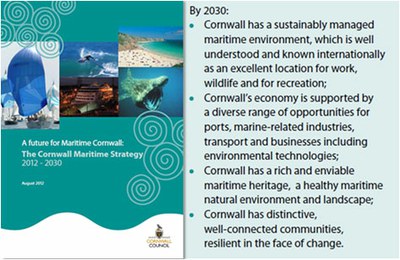5.3.3 Plymouth Sound to Fowey: Governance Arrangements

The site was selected by the VALMER project to represent a typical stretch of Cornish coast with common coastal and marine activities, pressures and issues. The boundaries do not accord to a single joined-up governance structure or physical unit for management.

It is important, however, to highlight that management structures regulations, statutory and non-statutory documents only have pockets of influence within the site, either geographical or thematic. Only members such as Cornwall Council have a broad remit across the site and, therefore, the potential to influence the whole of the site area.
A significant number of organisations and managers operate within parts of the site, for example, a number of terrestrial planning authorities (Plymouth City Council, Devon County Council & Cornwall Council). The Duchy of Cornwall, Cornwall Council and National Trust as landowners manage part of the case study’s coastline.
There are seven Harbour Authorities and the marine area is largely covered by the Cornwall Inshore Fisheries and Conservation Authority (IFCA) and Marine Management Organisation.
This gives rise to a considerable amount of management structures regulations, statutory and non-statutory documents. These deal with coastal risk management, via the Shoreline Management Plan, landscape conservation, via the AONB Management plan, development control via Local Plans, and estuary management, for example, through the Fowey and the Tamar Estuaries Management Plans. In policy terms, the site can be regarded as ‘policy congested’ in light of the plethora of overlapping and complimentary plans and strategies relating to coastal and marine management.
 In September 2012 Cornwall Council published its Cornwall Maritime Strategy. This high-level strategy document is the first of its kind and seeks to guide the future direction of work relating to maritime Cornwall. Maritime Action Plans have been drafted to support the strategy’s vision, aims and objectives. The strategy has considerable potential to shape the future direction of coastal and marine management in the case study area.
In September 2012 Cornwall Council published its Cornwall Maritime Strategy. This high-level strategy document is the first of its kind and seeks to guide the future direction of work relating to maritime Cornwall. Maritime Action Plans have been drafted to support the strategy’s vision, aims and objectives. The strategy has considerable potential to shape the future direction of coastal and marine management in the case study area.

